Lecture
In explanatory dictionaries, reference books, encyclopedias, you can find many definitions of what are emotions.
Thus, from a physiological point of view, emotion is the active state of the system of specialized brain structures that induces the body to change the behavioral response in the direction of minimizing or maximizing this state. According to Charles Darwin , emotion (from the French. Emotion - feeling) is a mental process of impulsive regulation of behavior, based on the sensual reflection of the needful significance of external influences, their auspiciousness or harmfulness for the individual’s life activity.
PK Anokhin described emotions as a special class of subjective psychological states, reflecting in the form of immediate experiences, sensations of a pleasant or unpleasant attitude of the person to the world and people, the process and results of his practical activity.
There is also such a definition: emotion is a specific state of the psychic sphere, one of the forms of a holistic behavioral reaction that involves many physiological systems and is conditioned both by certain motives, needs of the organism, and the level of their possible satisfaction.
In these definitions, the key concepts are: the state of body systems, subjective experiences, attitudes, behavioral responses, brain activity, needs, adaptation.
These concepts reflect the significance of emotional reactions for the normal biological and psychological functioning of the organism, individual, personality, as well as the complexity and complexity of these processes.
Considering the emotional manifestations, there are four main components : hormonal, vegetative, behavioral, psychological.
Hormonal reactions stimulate a change in metabolism in accordance with the effects and load and help to maintain blood glucose levels, which is accompanied by an increase in its consumption by the brain.
The vegetative response facilitates behavior, providing an increase in blood flow to the muscles and increased metabolism.
Behavior is mediated by a change in muscle activity and is aimed at bringing the internal experience into alignment with the external situation.
The psychological component is a wide range of subjective experiences, the diversity and intensity of which depends on the type of person.
Thus, emotions are not only experienced, but also expressed in the form of physical manifestations: mimicry (eye movement, changing the position of lips, eyebrows), pantomimic (gestures, poses), tone of voice (vocal mimicry), a number of vegetative phenomena (changing heart rate and respiration, redness or blanching, changes in muscle tone, trembling, sweating), biochemical changes in the body (adrenaline secretion by the adrenal glands, an increase in blood glucose, protein in the urine, etc.). The study of these processes lies at the basis of the identification of emotions, the evaluation of their role in the body and the organizations of behavior.
A. N. Leontiev singled out three types of emotional processes: affect, actually emotions and feelings.

From a physiological point of view, emotion is the active state of a system of specialized brain structures that induces the body to change a behavioral response in the direction of minimizing or maximizing this state.
There are three types of emotional phenomena: affects, the actual emotions and feelings.
Affects are strong short-term experiences that are accompanied by pronounced motor and autonomic responses. In humans, affects can be caused by both biologically significant factors and social ones. A distinctive feature of affects is that they occur during the cash situation.
Actually, emotions are a long-term current state, not always accompanied by external manifestation. Actually, emotions arise on the basis of ideas about experienced and imagined situations. They express an evaluative, subjective attitude to the emerging or possible situation. As a result, the actual emotions can anticipate situations and events that have not yet occurred.
Feelings are emotions that arise on the basis of social and ideal needs as a result of the generalization of emotions and are associated with a subjective view of an object or phenomenon. Feelings express a stable emotional relationship that has developed in the subject in the course of its activities.
General sensations are conditions that occur regularly at certain intervals in connection with the excitation of certain receptors (temperature, pain, etc.). General sensations are distinguished from other emotional phenomena by a lesser degree of subjectivity of experiences.
Mood is a flow or flow of hedonically oriented ideas, thoughts and images taken from memory. Mood is less specific than the actual emotion. The function of the mood is to inform the person about his general condition and needs. Mood stimulates activity, being an important regulator of human behavior. Mood can be conscious and unconscious. Reaching a certain threshold, it can be transformed into the actual emotion, but these types of emotional phenomena can coexist, affecting each other.
Emotions are present in the composition of any human activity. They can perform as a holistic assessment function, signaling the degree of satisfaction of needs, and a phased assessment and correction of activities.
G. A. Vartanyan proposed to classify emotions into primary and secondary. Basic (basal, primary, unbelievable, unconditioned-reflex) are associated with disturbance and restoration of homeostasis. These emotions are an integral part of biological (vital) needs. Secondary (individually estimated - “probabilistic”), associated with the attitude to what is happening and the satisfaction or dissatisfaction of diverse needs. These emotions are divided by people into "pleasant" and "unpleasant." Allocate leading and situational emotions. They are associated with different phases of behavior. Leading emotions signal the body about the dissatisfaction of its needs and encourage them to search for a target object, stimulating a certain behavior.
Situational emotions arise as a result of evaluations of the results of individual stages of behavior. They encourage the subject to act in the same direction or to change behavior, tactics, ways to achieve the goal.
K. Izard proposed to divide all emotions into contributing psychological entropies and aimed at inducing constructive behavior.
There are also approaches according to which emotions are divided into negative and positive.
Negative emotions are associated with the dissatisfaction of any needs. These emotions include: fear, horror, anger, rage, displeasure, disgust, sadness, melancholy, etc. Negative emotions based on unpleasant subjective experiences lead to the realization of adaptive behavior aimed at eliminating the source of physical or psychological danger. Within the framework of cognitive psychology and psychotherapy (A. T. Beck, A. Ellis), their specificity is determined through certain intellectual actions:
- anger occurs when obstacles in the way of reaching the goal occur and serves to awaken the energy required to destroy the obstacle;
- sadness occurs in a situation of loss of a significant object and serves to reduce the level of energy for its further use;
- fear helps to avoid danger or to mobilize to attack;
- contempt supports own self-esteem and domination behavior;
- shyness signals the need for privacy and intimacy;
- guilt establishes a subordinate role in the social hierarchy and indicates the possibility of losing self-esteem;
- disgust leads to the repulsion of harmful objects.
Positive emotions (pleasure, pleasure, joy, interest) can be viewed as the result of satisfying biological and social needs. Also, emotions are accompanied by increased creative performance, low fatigue, increased resistance to harmful factors.
So, interest is the basis of creativity, the most important motivation in the development of knowledge, skills, and intelligence. Emotion of interest supports any research, study, constructive activity, development of skills, interpersonal and family relations, plays a leading role in the development and formation of personality.
Joy is an emotion characterized by a sense of confidence, satisfaction, and personal significance. Due to the fact that the feeling of joy harmonizes a person's state, saturating him with self-satisfaction, satisfaction with the world around him and the world as a whole, joy makes everyday life easier, brings the ability to cope with difficulties, achieve goals, promotes confidence, calms a person, reducing his stressful state.
When evaluating positive and negative emotions, one should always keep in mind that their role in the body is not unambiguous and they can cause opposite effects depending on the level of satisfaction of needs, the state of the body, strategy and tactics of behavior, the final goal of the activity, etc.
Given the nature of the body's behavior in emotional states, isolated sthenic, causing vigorous activity, and asthenic, - depressing active forms of behavior.
A more detailed description of the various emotions will be presented in subsequent sections.
In humans, this signal-expressive function of emotions has not lost its meaning and provides him with non-verbal communication. Emotional and expressive movements indicate the inner state of the speaker and his attitude to what is happening at the moment. They can also have a certain impact on who is the subject of perception of emotional and expressive movements. But not all manifestations of feelings are equally easily recognized. The most easily recognized is horror, then disgust and surprise. A little informative about the feelings experienced by a person is the expression of his mouth.
The first information about the cerebral organization of emotions was obtained in experiments on animals of different types during the destruction and stimulation of different departments and brain structures, as well as in the study of the functions of the human brain in clinics in connection with brain operations and various medical procedures. Currently, there are many methods and techniques of non-individual brain research (see topic 2 "Basic methods of psycho-physiological research"), which allow to evaluate the role and contribution of various brain structures in the formation of emotional processes.
Emotion as an activity of brain structures . W. Kennon (Cannon, 1927) and P. Bard (Bard, 1929) proposed a concept, the essence of which lies in the fact that psychological awareness and physiological response in the process of emotional response occurs almost at the same time. Information about the emotional signal enters the thalamus, from it at the same time - into the cerebral cortex of the brain, which leads to awareness, and the hypothalamus, which leads to a change in the vegetative status of the organism (Fig. 20). Further research revealed a significant number of brain structures involved in the formation of emotions.
Hypothalamus Using the technique of self-reflection, a pleasure center was discovered (Olds, Fobes, 1981). In a similar experiment, electrodes implanted in the rat's brain, pedal contact and source of electrical current are included in one circuit. While moving, the rat could press the pedal. If the electrodes were implanted in the region of the lateral hypothalamus, then after a single press, the rat did not stop doing it. Some of them pressed the pedal up to 1,000 times per hour and died as they stopped performing the actions necessary for survival.
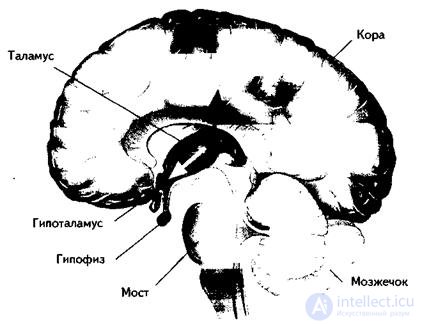
Fig. 20. The Kennon-Bard model involves the simultaneous flow of information from the thalamus into the cortex and subcortical structures.
You can change the emotional state of the animal by introducing certain biologically active substances in certain areas of the hypothalamus. The role of this brain structure in the emotional response has been demonstrated many times. In the lateral hypothalamus, two types of neurons have been identified that respond differently to emotional situations. Один тип нейронов был назван мотивационным, поскольку они обнаруживали максимальную активность в мотивационном поведении, а другой – подкрепляющим, поскольку эти клетки активировались при насыщении животного (Зайченко и др., 1995).
Миндалина (амигдала) . X. Клювер и П. Бьюси (Kluver, Bucy, 1939) удалили височные доли коры большого мозга у обезьян и описали синдром, позднее названный их именем. У обезьяны, до операции являющейся агрессивным альфа-самцом, после экстирпации височной доли исчезла былая агрессивность и страх, но обнаружилась гиперсексуальность. С одной стороны, эти данные свидетельствуют о важности височных долей для развития агрессии, с другой – демонстрируют наличие реципрокных отношений между сексуальностью и агрессивностью. Это противоречит представлению К. Лоренца (Lorenz, 1969), утверждавшего идентичность агрессивности и мужской сексуальности, поскольку, с его точки зрения, сексуальное поведение является составной частью агрессивного.
Установлено, что синдром Клювера-Бьюси обусловлен отсутствием миндалины. Сейчас доказано, что эта структура формирует ответ организма на аверсивный стимул (вызывающий реакцию избегания). Любой эмоциональный ответ ассоциируется с обстоятельствами, в которых он возникает. Так происходит выработка классического условного рефлекса, где подкреплением является то или иное эмоциональное состояние организма. Этот тип обучения называется условным эмоциональным ответом.
Миндалина играет роль в нескольких видах эмоционального поведения: агрессии, страхе, отвращении, материнском поведении. Эта структура является фокусом сенсорной и эффекторной систем, отвечая за поведенческий, вегетативный и гормональный компоненты условного эмоционального ответа, активируя соответствующие нервные круги, расположенные в гипоталамусе и стволе мозга.
Дж. Е. Леду (LeDoux, 1987) показал необходимость центрального ядра миндалины для развития условного эмоционального ответа, поскольку при его отсутствии выработать рефлекс не удавалось (рис. 21). Как видно из рисунка, миндалина связана с латеральным гипоталамусом, отвечающим за вегетативный компонент эмоционального ответа, и с околоводопроводным серым веществом, которое организует поведенческий ответ. Миндалина также имеет проекции в области гипоталамуса, вовлеченные в реализацию гормонов стресса. Именно поэтому раздражение центрального ядра миндалины ведет к изъязвлению желудочно-кишечного тракта. Однако при оперативном удалении миндалины язва при стрессе не образуется. По-видимому, эту свою функцию она реализует через хвостатое ядро.

Fig. 21. Участие миндалины в формировании условного эмоционального ответа (Carlson, 1992)
Sensory associative cortex analyzes complex stimuli of sufficient complexity. Although individual emotional reactions in a person are caused by simple stimuli, most of them are quite complex, for example, the appearance in the field of view of one or another person. The amygdala receives information from the lower temporal cortex and the cortex of the temporal tubercle. Projections from the visual, auditory and somatosensory associative cortex go to the latter. Thus, the amygdala has information of any modality.
Дж. Л. Даунер в эксперименте разрушал левую миндалину у обезьян, параллельно производя комиссуротомию (Downer, 1961). Таким образом, левая половина мозга была лишена структуры, синтезирующей информацию всех сенсорных входов, и обезьяна не могла компенсировать этот недостаток информацией из правого полушария. До операции прикосновение к обезьяне вызывало агрессивную реакцию. После операции подобное поведение вызывалось лишь в том случае, когда животное смотрело правым глазом. При рассматривании левым глазом агрессивность отсутствовала. Это говорит, в частности, о том, что для эмоциональных реакций особое значение имеет правое полушарие головного мозга.
Роль таламуса в реализации условного эмоционального ответа . Большинство эмоциональных реакций достаточно примитивны, поскольку возникли довольно рано на пути эволюционного развития. Разрушение слуховой коры не влечет за собой отсутствие эмоционального условного ответа, тогда как разрушение таламуса неотвратимо ведет к невозможности его выработки.
Для образования условного эмоционального ответа на звук необходима сохранность медиальной части медиального коленчатого тела, отправляющего слуховую информацию в первичную слуховую кору больших полушарий головного мозга (рис. 22). Кроме того, нейроны медиального коленчатого тела проецируются в миндалину. Разрушение этих связей приводит к невозможности выработки эмоционального условного ответа на звуковой сигнал.
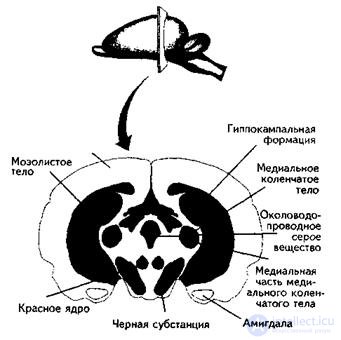
Fig. 22. Медиальное сечение мозга через медиальное коленчатое тело, которое получает информацию от слуховых систем и проецирует в подкорковые структуры (Carlson, 1992)
Точно так же для выработки условного эмоционального ответа на зрительный сигнал нужна сохранность латеральных коленчатых тел, несущих в мозг зрительную информацию.
Орбитофронтальная кора находится в основании лобных долей (рис. 23). Она имеет прямые входы от дорсомедиального таламуса, височной коры, вентромедиальной и теменной областей. Непрямые связи идут к ней от миндалины и обонятельной коры, проецируются в сингулярную кору, гиппокампальную систему, височную кору, латеральный гипоталамус, миндалину. Множественными путями связана с другими областями лобных долей головного мозга.
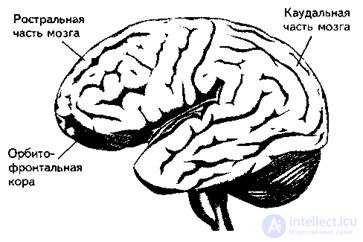
Fig. 23. Орбитофронтальная кора
Роль орбитофронтальной коры впервые стала определяться в середине XIX века. Важную информацию о функции этой области в эмоциональном поведении дал случай с подрывником Финеасом Гэйджем. Металлический стержень, выброшенный взрывом, пронзил лобную часть его головного мозга. Гейдж выжил, но его поведение значительно изменилось. Если до травмы он был серьезным и основательным, то после этого случая превратился в легкомысленного и безответственного человека. Поведение его характеризовалось детскостью и безалаберностью, ему трудно было составить план будущих действий, да и сами его действия были капризны и случайны.
Подобные повреждения снижают процессы торможения и самоконцентрации, меняют личностные интересы. Еще в 40-х годах XX столетия было набрано достаточно много материала о роли орбитофронтальной коры в эмоциональном поведении. Большая часть данных свидетельствовала о том, что повреждение ее, меняя эмоциональную сферу человека, не затрагивает интеллектуальный уровень.
Например, в одном курьезном случае человек страдал синдромом навязчивости, который проявлялся в постоянном мытье рук. Аномалия эта мешала ему вести нормальную жизнь и в конце концов привела к попытке самоубийства. Больной выстрелил себе в голову через рот, однако выжил, хотя и повредил фронтальную кору. Навязчивость при этом исчезла, а интеллектуальный уровень остался прежним.
Многочисленные исследования по разрушению орбитофронтальной коры, проводимые на животных, свидетельствовали о существенном изменении их поведения: исчезновении агрессивности и отсутствии видимых интеллектуальных отклонений. Это навело португальского ученого Эгаса Моница на мысль убедить нейрохирургов делать подобную операцию на людях. Он полагал, что такая операция могла бы снять у агрессивных психопатов патологическое эмоциональное состояние, сохранив интактным их интеллект. Несколько таких операций были действительно проведены, и их результаты подтвердили первоначальную мысль автора. За это Э. Мониц в 1949 г. получил Нобелевскую премию.
Позднее эта операция, названная лоботомией , была проведена тысячам больных. Особенно много таких хирургических вмешательств сделано американским солдатам, вернувшимся после Второй мировой войны с синдромом, который позднее стали называть по месту проведения военных действий «вьетнамским», «афганским», и т. д. Людям, длительно участвующим в военных действиях, свойственно при любой тревожной ситуации начинать физическую атаку, не успев подумать, обоснована ли такая реакция. Во всех других отношениях они не отличаются от нормы, являясь к тому же и физически здоровыми и работоспособными. Сейчас очевидно, что Э. Мониц ошибался, поскольку лоботомия ведет не только к снижению интеллектуального уровня, но, что не менее важно, к безответственному поведению. Такие больные перестают планировать свои действия, отвечать за них и, как следствие, теряют работоспособность и возможность жить самостоятельно.
В настоящее время полагают, что орбитофронтальная кора включена в оценку последовательности действий. Если эта область повреждена заболеванием, то испытуемый может оценить эмоциональную значимость стимула теоретически, т. е. легко сможет проанализировать ситуации на картинках и схемах. Однако он не сумеет применять эти знания в жизни. Подобным образом Гейдж, о котором было сказано ранее, терял одну работу за другой, истратил все сбережения и в конце концов лишился семьи.
Можно полагать, что орбитофронтальная кора не прямо включена в процесс принятия решения, но обеспечивает трансляцию этих решений в жизнь, в конкретные чувства и поведение. Вентральные связи этой области коры с диенцефалоном и височной областью приносят ей информацию об эмоциональной значимости сигнала. Дорсальные связи с сингулярной корой позволяют ей влиять как на поведение, так и на вегетатику.
Сингулярная кора играет важную роль в формировании эмоционального переживания (рис. 24). Дж. У. Папец (Papez, 1937) предположил, что сингулярная кора, энторинальная кора, гиппокамп, гипоталамус и таламус образуют круг, имеющий непосредственное отношение к мотивации и эмоции. Психолог П. Д. Маклин (MacLean, 1949) включил в эту систему также миндалину и назвал ее лимбической. Сингулярная кора обеспечивает взаимодействие между структурами, принимающими решение в лобной коре, эмоциональными структурами лимбической системы и мозговыми механизмами, контролирующими движение. Она взаимодействует в прямом и обратном направлениях с остальной лимбической системой и другими областями лобной коры. Электрическая стимуляция сингулярной извилины может вызвать переживание положительных или отрицательных эмоций (Talairach е. а., 1973).
Повреждение сингулярной коры связано с акинетическим мутизмом, при котором больные отказываются говорить и двигаться. Значительная травма этой области несовместима с жизнью. Есть основание полагать, что она играет инициирующую роль в эмоциональном поведении.
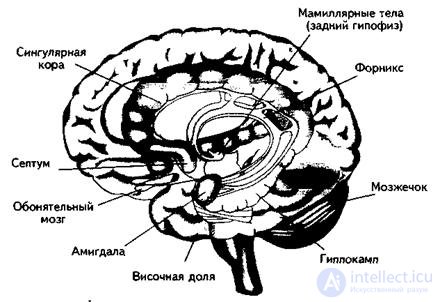
Fig. 24. Сингулярная кора (Carlson, 1992)
Оригинальную теорию мозговой организации эмоций предложил Дж. Грей. По его мнению, следует выделять три мозговые системы, определяющие появление трех основных групп эмоций: тревожности, радости-счастья и ужаса-гнева.
Table 5
Brain systems that determine the appearance of emotions
|
Systems that determine the type of behavior |
Emotions |
Structures |
Biologically important |
|
Behavioral braking system |
Anxiety - Depression |
Septum, entorhinal cortex, dentate gyrus, subicular region, hippocampus |
Cortisol, adrenotropic hormone, endorphins |
|
Fight and flight system |
Rage, anger, fear |
Tonsil, medial hypothalamus, central gray matter |
Adrenaline, podradenaline, testosterone |
|
System of approaching behavior |
Serenity, high spirits, confidence, happiness, joy |
Basal ganglia, substantia nigra, dopaminergic fibers, thalamic nuclei; motor, sensory, prefrontal area feed |
Dopamine, serotonin, opiates, testosterone |
The brain system associated with the emergence of anxiety, was called the system of behavioral inhibition (Behavior Inhibition Sistem, BIS). This system responds to signals of punishment, cancellation of positive reinforcement, incentives containing novelty. The main structures of this system are the septum, the entorhinal cortex, the dentate gyrus, the subicular region, and the hippocampus (septohypocampal system). With general behavioral inhibition, an increase in the level of cortisol, release of endorphins, adrenocorticotropic hormone is noted.
The second system relates to the organization of the behavior of fight and flight (Fight-flight, FF). It is associated with the emotions of rage, anger and horror. Its structures respond to unconditional aversive (rejected) stimuli. The structure of this system consists of three main structures: the amygdala, the medial hypothalamus and the central gray matter. The emotion of anger is accompanied by an increase in the level of the pores of adrenaline and testosterone. With the emotion of fear, adrenaline rush prevails, the level of cortisol in the blood increases (Behavior ApproachSistem, BAS).
The third brain system provides approaching behavior . Adequate incentive signals (food, water, etc.) are adequate for its elements. The main structures of the brain that ensure its functioning are the basal ganglia, the dopaminergic fibers of the substantia nigra, the thalamic nucleus, the motor, sensory, and prefrontal areas of the cortex. Emotions arising from the activation of this system are associated with a pleasant anticipation, hope, experience of recovery, happiness. Thus, according to J. Gray’s theory, positive emotions are dopaminergic in nature. However, the positive emotional state of a person is largely determined by the level of serotonin. With an increase in his concentration in the brain, a person’s mood rises. This system is often called the motor programming system.
The individual characteristics of the human emotional sphere depend on the balance of the three brain systems. Increased individual activity of the septo-hippocampal system predetermines a person's tendency to anxiety. The dominance of the functions of the fight and flight system reflects a person's tendency to aggression or active defensive behavior. The degree of expression of positive emotions depends on the contribution made by the system of approximating behavior.
Thus, it is possible to identify certain modulating systems of the brain and separate complexes of mediators, gomons and peptides, which are associated with the corresponding emotional states and their classification.
Currently, a large number of experimental and clinical data on the role of the cerebral hemispheres in the regulation of emotions has been accumulated. The study of the functions of the left and right hemispheres revealed the existence of emotional asymmetry of the brain. According to V. L. Deglin, the temporary shutdown of the left hemisphere with an electroconvulsive current shock causes a shift in the emotional sphere of the "right-hemisphere person" towards negative emotions. The mood worsens, he is pessimistic about his position, complains of feeling unwell. Turning off the right hemisphere causes the opposite effect - improving the emotional state. TA Dobrokhotova and N. N. Bragina found that patients with lesions in the left hemisphere are anxious, anxious. Right-sided lesion is combined with lightheadedness, carelessness. The emotional state of complacency, irresponsibility, carelessness, arising under the influence of alcohol, is associated with its predominant effect on the right hemisphere of the brain.
Demonstration of films of different content using contact lenses in the right or left field of view showed that the right hemisphere responds faster to slides with an expression of sadness, and the left to slides of joyful content. According to others, the right hemisphere will more quickly identify emotionally expressive faces, regardless of the quality of the emotion.
The recognition of facial expressions is more related to the function of the right hemisphere. It worsens with the defeat of the right hemisphere. Damage to the temporal lobe, especially on the right, violates the identification of the emotional intonation of speech. When you turn off the left hemisphere, regardless of the nature of the emotion improves the recognition of emotional coloring of the voice.
Turning off the left hemisphere makes the situation incomprehensible, non-verbalizable and, therefore, emotionally negative. Turning off the right hemisphere makes the situation simple, clear, understandable, which causes the predominance of positive emotions.
Emotional brain asymmetry is also characteristic of normal, healthy people. For persons with a dominant right hemisphere, heightened anxiety, neuroticism is characteristic. The predominance of the functions of the left hemisphere, determined by a group of motor, visual and auditory techniques, is combined with low anxiety values.
There is evidence that the right and left hemispheres are capable of producing emotions of a different sign. In a healthy brain, the sign of the emotional background depends on the functional state of the individual, the activation of the leading speech hemisphere: with its sufficient level, the positive background prevails, with a decrease - negative. In the case of functional or organic shutdown of one of the hemispheres, the sign of emotional asymmetry is determined by the activation of the remaining safe hemisphere.
In general, the problem of hemisphere of emotional reactions remains one of the most actively studied. Thus, when assessing the role of the left and right hemispheres in the formation of emotions, the different specializations of the brain in men and women, the profile of functional sensorimotor asymmetry and many other factors should be taken into account.
Individual differences associated with the characteristics of the functional asymmetry of the brain, as well as with the properties of temperament, are one of the factors that determine the specificity and strength of emotional experience. The dimensions of temperament, which are most closely associated with emotions, include anxiety, strength - weakness of the processes of arousal, extraversion - introversion, impulsivity, emotionality.
Extroverts have a lower threshold for social incentives with a positive sign and therefore more often respond with emotions of joy and interest. They are more sensitive to reward, and introverts to punishment.
The most successful attempt to integrate numerous facts testifying to the influence of various properties of individuality on the emotional sphere of a person was made by P. V. Simonov in his conception of the system of four brain structures . According to this theory, the individual features of the interaction of the frontal cortex, hippocampus, hypothalamus and tonsil form the basis not only for the types identified by Hippocrates and Pavlov, but also for the extraversion properties - introversion and neuroticism - the main dimensions of temperament in Aysenck's concept (see Fig. 25).
According to Simonov, the predominance of the functions of the frontal cortex and hypothalamus in the subject will determine the frequent actualization of needs and behavior aimed at satisfying it. In this case, the subject will ignore everything that distracts him from the intended goal. These behaviors are characteristic of choleric temperament.
The functional predominance of the hippocampus-amygdala system means the willingness to respond to a wide range of signals, including the minor ones. When it is difficult to identify the dominant motivation (amygdala), the behavior of such a subject is characterized by indecision, endless fluctuations with its increased sensitivity to stimuli and a tendency to overestimate the importance of events. This characteristic coincides with the description of melancholic - the weak type according to Pavlov.
The predominance of the hypothalamus-hippocampus system creates a combination of the dominant need with generalized responses to the signals of unlikely events and unexplained destination. This picture corresponds to the typical sanguine person - a strong, balanced, mobile type.
The dominance of the amygdala system - the frontal cortex determines well-balanced needs without highlighting one of them. A subject with similar properties ignores many events and responds only to highly significant stimuli. This behavior is typical for phlegmatic - strong, balanced, inert type.
The predominance of the functions of informational structures - the frontal cortex and the hippocampus - determines the subject’s preferential orientation towards the external environment and its dependence on the events occurring in it. Such features are characteristic of an extrovert.
The predominance of motivational systems - the hypothalamus and the amygdala - creates an introvert with its stability of internal motives, attitudes and their low dependence on external influences.
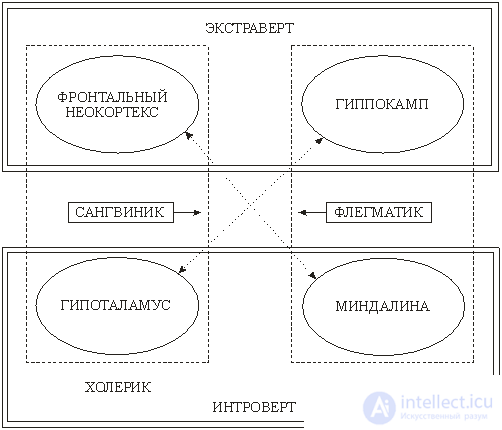
Fig. 25. Diagram of the dependence of temperaments, parameters of extraversion - introversion and neuroticism on the individual characteristics of the interaction of four brain structures, according to P. V. Simonov
Comments
To leave a comment
Psychophysiology
Terms: Psychophysiology